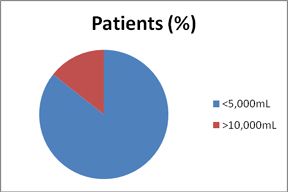Can Massive Blood Loss Be Predicted in Women With Placenta Accreta?
Approximately 10% of maternal deaths in the United States are attributed to obstetric hemorrhage, with peripartum hysterectomy for placenta accreta associated with substantial morbidity. To help reduce this morbidity, Dr Jason Wright, assistant professor of obstetrics and gynecology in the College of Physicians and Surgeons, Columbia University, New York, and researchers explored the risk factors associated with large-volume blood loss in patients with placenta accreta who undergo hysterectomy in order to help develop referral recommendations to tertiary facilities with expertise in this condition.
Approximately 10% of maternal deaths in the United States are attributed to obstetric hemorrhage, with peripartum hysterectomy for placenta accreta associated with substantial morbidity. To help reduce this morbidity, Dr Jason Wright, assistant professor of obstetrics and gynecology in the College of Physicians and Surgeons, Columbia University, New York, and researchers explored the risk factors associated with large-volume blood loss in patients with placenta accreta who undergo hysterectomy in order to help develop referral recommendations to tertiary facilities with expertise in this condition.
Wright and colleagues conducted a retrospective study of 77 women with pathologically confirmed placenta accreta who delivered between 2000 and 2010 at their institution. Preoperative, intraoperative, and postoperative treatment data were collected and analyzed. Estimated blood loss and the number of units of packed red blood cells (PRBCs) for each patient were identified. For the purpose of this study, the researchers defined massive blood loss as 5000 mL or more and defined large volume transfusion as 10 or more units of PRBCs.
In their cohort more than half (57.1%) the women were at least 35 years old. Hysterectomies were required in 88.3% of the deliveries; 72.7% of the women had placenta previa, 67.5% of the women had placenta accreta, and 32.5% of the women had placenta increta or percreta. About one-quarter (24.7%) of the women were at least 37 weeks’ gestation, but about half (50.6%) of the deliveries were elective. Mean estimated blood loss was 3000 mL (see Figure for additional information), and the mean transfusion requirement was 5 units of PRBCs.
Figure. Amount of estimated blood loss in patients.

No association was found between maternal age, gravidity, number of previous cesarean deliveries, or antenatal bleeding and blood loss of 5000 mL or more. However, women who had a diagnosis of placenta accreta before delivery were more likely to experience massive blood loss. Specifically, 41.7% of women with ultrasonography scans indicative of abnormal placentation experienced an estimated blood loss of at least 5000 mL; only 12% of women without such a diagnosis had similar blood loss rates.
Interestingly, women in the latter half of the study were more likely to experience heavier bleeding: 41.9% of the women who delivered between 2006 and 2010 had an estimated blood loss of 5000 mL or more as compared to 17.7% of the women who delivered between 2000 and 2005. Approximately one-quarter (26.9%) and just under one-half (40.0%) of the women with placenta accreta and either a placenta increta or placenta percreta, respectively, had heavy bleeding. The researchers surmise that some of these increases reflect more severe underlying placental pathologic disease.
“Our findings suggest that it is difficult to predict massive blood loss and large volume transfusion in women with placenta accreta,” Wright and colleagues concluded. “Despite the difficulty in the prediction of which of the cases who were diagnosed antepartum will have heavy blood loss, early detection allows for the referral of patients to tertiary centers with expertise in the management of placenta accreta.”
More Information
UpToDate:Diagnosis and Management of Placenta AccretaPlacenta Accreta:Spectrum of US and MR Imaging Findings
Related Content
Placenta Accreta and Percreta: Sonographic, MRI, and Surgical Correlation Educational Tutorial:Placenta Accreta
References:
Reference
Wright JD, Pri-Paz S, Herzog TJ, et al. Predictors of massive blood loss in women with placenta accreta. Am J Obstet Gynecol. 2011;205:38.e1-6.
S1E4: Dr. Kristina Adams-Waldorf: Pandemics, pathogens and perseverance
July 16th 2020This episode of Pap Talk by Contemporary OB/GYN features an interview with Dr. Kristina Adams-Waldorf, Professor in the Department of Obstetrics and Gynecology and Adjunct Professor in Global Health at the University of Washington (UW) School of Medicine in Seattle.
Listen
Study shows a healthy prenatal diet could be upstream obesity prevention strategy
December 26th 2024"Our findings support the recommendation of a healthy diet based on the current guidelines (as measured by the HEI) during pregnancy, since it may reduce patterns of infant growth outside reference ranges."
Read More
Early pregnancy cannabis use high in states with recreational legalization
November 11th 2024A population-based time-series analysis California before, during and after legalization show a rising trend in women using cannabis while pregnancy especially when the state has legalized the drug.
Read More
